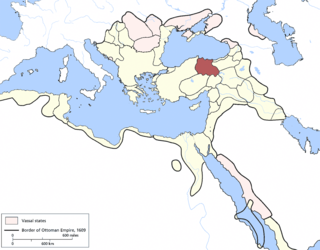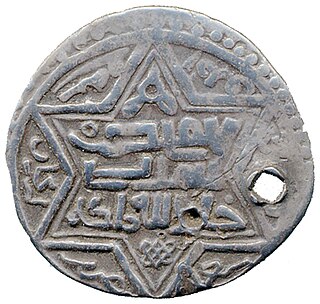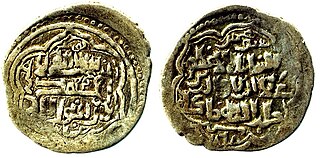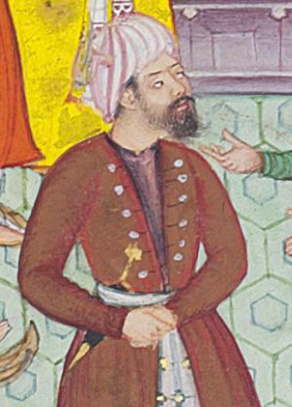Related Research Articles
Kilij Arslan II or ʿIzz ad-Dīn Kilij Arslān ibn Masʿūd was a Seljuk Sultan of Rûm from 1156 until his death in 1192.

The Eyalet of Rûm, later named as the Eyalet of Sivas, was an eyalet of the Ottoman Empire in northern Anatolia, founded following Bayezid I's conquest of the area in the 1390s. The capital was the city of Amasya, which was then moved to Tokat and later to Sivas. Its reported area in the 19th century was 28,912 square miles (74,880 km2).

The Sultanate of Rûm was a culturally Turco-Persian Sunni Muslim state, established over conquered Byzantine territories and peoples (Rûm) of Anatolia by the Seljuk Turks following their entry into Anatolia after the Battle of Manzikert (1071). The name Rûm was a synonym for the medieval Eastern Roman Empire and its peoples, as it remains in modern Turkish. The name is derived from the Aramaic (rhπmÈ) and Parthian (frwm) names for ancient Rome, via the Greek Ῥωμαῖοι (Romaioi).
Ala ud-Din Timurtash was a member of the Chobanids who dominated politics in the final years of the Ilkhanate.

Ghiyath al-Din Kaykhusrawibn Kayqubād or Kaykhusraw II was the sultan of the Seljuqs of Rûm from 1237 until his death in 1246. He ruled at the time of the Babai uprising and the Mongol invasion of Anatolia. He led the Seljuq army with its Christian allies at the Battle of Köse Dağ in 1243. He was the last of the Seljuq sultans to wield any significant power and died as a vassal of the Mongols.

The Eretnids were a dynasty that ruled a state spanning central and eastern Anatolia from 1335 to 1381. The dynasty's founder, Eretna, was an Ilkhanid officer of Uyghur origin, under Timurtash, who was appointed as the governor of Anatolia. Some time after the latter’s downfall, Eretna became the governor under the suzerainty of the Jalayirid ruler Hasan Buzurg. After an unexpected victory at the Battle of Karanbük, against Mongol warlords competing to restore the Ilkhanate, Eretna claimed independence declaring himself the sultan of his domains. His reign was largely prosperous earning him the nickname Köse Peyghamber.
Kaykaus I or Izz ud-DinKaykaus ibn Kaykhusraw was the Sultan of Rum from 1211 until his death in 1220. He was the eldest son of Kaykhusraw I.

Qāḍī Aḥmad Burhān al-Dīn was vizier to the Eretnid rulers of Anatolia. In 1381, he took over Eretnid lands and claimed the title of sultan for himself. He is most often referred to by the title Qadi, a name for Islamic judges, which was his first occupation.

The Emirate of Erzincan was an emirate that controlled much of Eastern Anatolia in the fourteenth and early fifteenth centuries.

Ala al-Din Eretna was the first sultan of the Eretnids, reigning between 1343–1352 in central and eastern Anatolia. Initially an officer in the service of the Ilkhanate officer Chupan and his son Timurtash, Eretna migrated to Anatolia following Timurtash's appointment as the Ilkhanid governor of the region. He took part in Timurtash's campaigns to subdue the Turkoman chiefs of the western periphery of the peninsula. This was cut short by Timurtash's downfall, after which Eretna went into hiding. Upon the dissolution of the Ilkhanate, he aligned himself with the Jalayirid leader Hasan Buzurg, who eventually left Anatolia for Eretna to govern when he returned east to clash with the rival Chobanids and other Mongol lords. Eretna later sought recognition from Mamluk Egypt to consolidate his power, although later he played a delicate game of alternating his allegiance between the Mamluks and the Mongols. In 1343, he declared independence as the sultan of his domains. His reign was largely described to be prosperous, with his efforts to maintain order in his realm such that he became known as Köse Peyghamber.
Hund Şehzade was an Ottoman princess, granddaughter of claimant to the throne Süleyman Çelebi, and great-granddaughter of Sultan Bayezid I of the Ottoman Empire. She was wife of Barsbay, and later of Sayf ad-Din Jaqmaq, Egypt Sultans of the Burji dynasty.
Fakhr al-Din Qutlugh-bey was the second Aq Qoyunlu bey, ruling from 1362-1389. His full name was Haji Fakhr al-Din Kutlug ibn Tur Ali-bey.

Ghiyath al-Din Muhammad I was the second Sultan of the Eretnids in central and eastern Anatolia, ruling from 1352 until his death. He was enthroned at a young age and struggled to maintain his authority over the state his father, Eretna, had founded. Although he was initially preferred over his older brother Jafar, Muhammad was deposed by his emirs early into his reign and was replaced by Jafar. After some time in exile, he returned, restored his throne, and killed his brother. Though, throughout his reign, he dealt with rebellions and lost land to local Turkoman lords, the Dulkadirids, and the Ottomans. After putting an end to his former vizier Khoja Ali Shah's revolt and returning to the capital, Kayseri, Muhammad was murdered by his emirs, who crowned his son Ali as the new sultan.
Zayn al-Din Qaraja Beg was a Turkoman chieftain who founded the Dulkadirid principality in southern Anatolia and northern Syria, ruling from 1337 to 1353. Before his ascendance, Qaraja competed with Taraqlu, another local Turkoman warlord, over the administration of the northern frontier of the Mamluks. After gaining recognition from the Mamluk Sultan Al-Nasir Muhammad, he became the head of a client state on their Anatolian extremity. During his rule, Qaraja grew more ambitious and clashed with various Mamluk governors who were against his expanding influence. Qaraja took advantage of the political turmoil within the Mamluks and declared independence in 1348. However, this led to his imprisonment and subsequent execution in 1353.
Ghars al-Din Khalil Beg was the second ruler of the Turkoman Dulkadirid principality, reigning from 1353 to 1386. Having actively taken part in military pursuits during his father Zayn al-Din Qaraja's rule, he further expanded the influence of the Dulkadirids and clashed with the Mamluk suzerainty, contributing to the growing tension between the Mamluks and Dulkadirids. Raids by Khalil in the northern frontier with the Mamluks prompted the Mamluk sultan to provoke dissension in the Dulkadir dynasty. The sultan incited Khalil's brother Sarim al-Din Ibrahim, who sought Mamluk recognition for his domains near Harpoot, to assassinate the ruler, Khalil. Ghars al-Din was killed in an ambush and was succeeded by his other brother Shaban Suli.

Ala al-Din Ali was the third Sultan of the Eretnids ruling from 1366 until his death. He inherited the throne at a very early age and was removed from administrative matters. He was characterized as particularly keen on personal pleasures, which later discredited his authority. During his rule, emirs under the Eretnids enjoyed considerable autonomy, and the state continued to shrink as neighboring powers captured several towns. The capital, Kayseri, temporarily came under Karamanid control. Kadi Burhan al-Din rose to power as the new vizier and further dispatched Ali to lead several campaigns, most of which were unsuccessful. Ali died of the plague in Kazova in an expedition to subdue Shadgeldi, the emir of Amasya.
Hajji Sayf al-Din Shadgeldi Padishah was Emir of Amasya from 1359 until his death. He was the second oldest son of Hajji Kutlu Shah and became the emir of Amasya in August–September 1359. He received his education from Mawlana Fakhr al-Din Ilyas in Amasya and was a classmate of Aqsara'i. He was initially loyal to Eretna but exercised autonomy following his death.
Muhammad II Chelebi was the fourth and last Sultan of the Eretnids. He was crowned when he was 7 years old, after his father died in August 1380 from the plague. His regent was Kadi Burhan al-Din, who proclaimed himself as the ruler by January 1381. According to Ibn Khaldun and Ibn Hajar al-Asqalani, Muhammad was killed by Kadi Burhan al-Din in 1390.

Mutahharten, also known as Taharten, was Emir of Erzincan from 1379 until his death. He claimed sovereignty when he assumed power, which prompted Sultan Ala al-Din Ali to go on an expedition to reinstate Eretnid authority over Erzincan. While Mutahharten ultimately repelled Ali, the latter was eventually replaced by his vizier Kadi Burhan al-Din, who was determined to restore the sultanate's former boundaries. Burhan al-Din and Mutahharten were involved in a long-lasting conflict, which was interrupted by the advent of Timur. In grave fear of him, Mutahharten contently swore allegiance and halted his campaigns in Anatolia, but Timur's departure reignited the conflict between Mutahharten and Burhan al-Din. Often overpowered by his enemies, Mutahharten forged alliances with various groups but did not hesitate to turn against his former allies when he saw fit, such as the Aq Qoyunlu. On the other hand, Mutahharten's relations with the Empire of Trebizond and his Christian subjects were consistent, as he favored them for their economic contribution to his realm through trade.
Ghiyath al-Din Ahi Ayna Beg was Emir of Erzincan from 1348 until his death. Thought to be a local ahi, he gained control of the region and city of Erzincan through a purchase from his predecessor sometime before 1348. He was initially loyal to Eretna, after whose death he practiced some degree of autonomy within the Eretnid Sultanate. He waged multiple wars against the Empire of Trebizond and Kingdom of Georgia. He is recorded to have died a shaheed (martyr) and was succeeded by Pir Husayn.
References
- ↑ Çayırdağ 2000, p. 443.
- ↑ Çayırdağ 2000, p. 444.